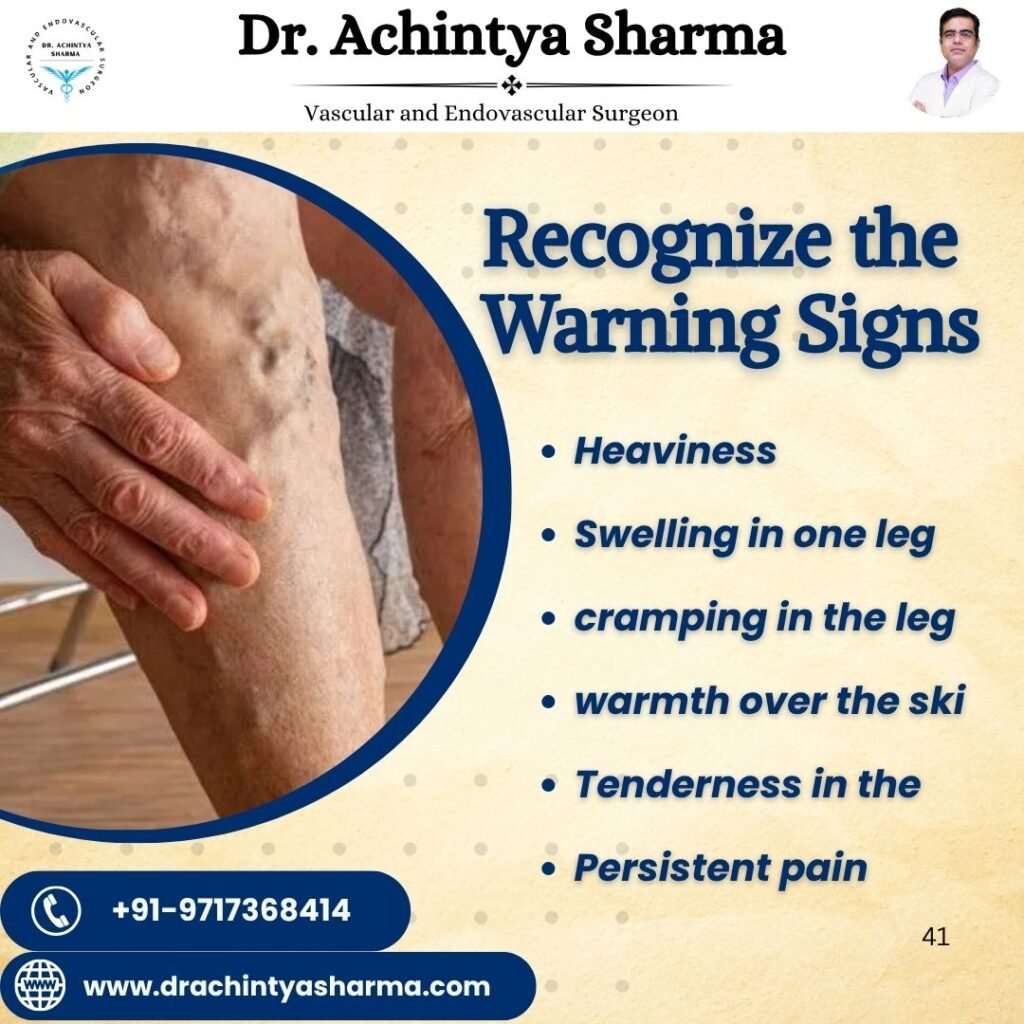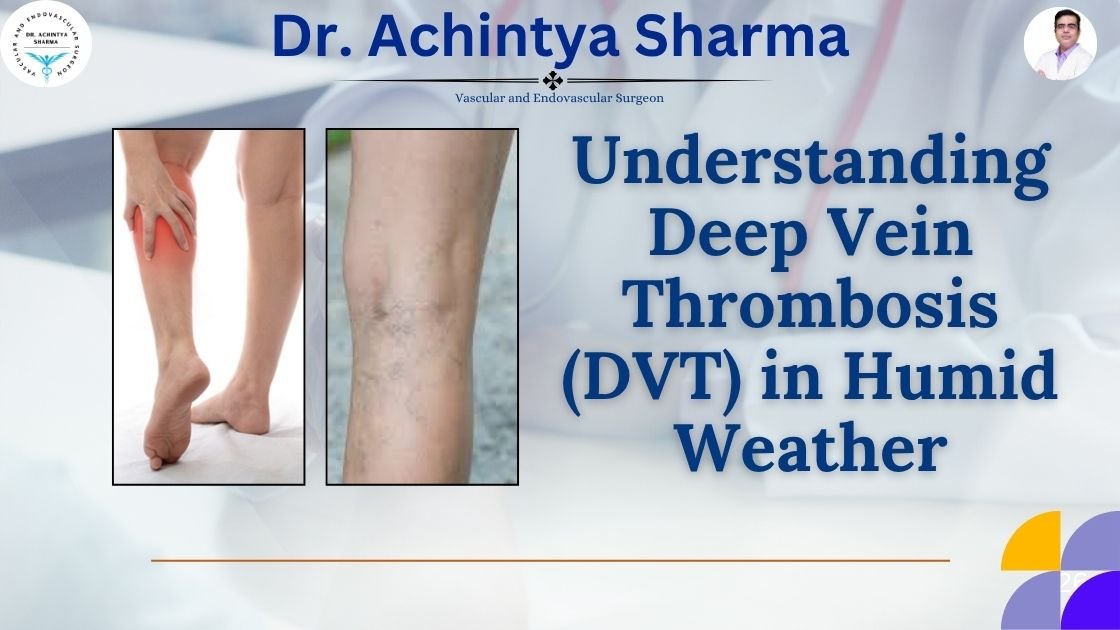When temperatures rise and humidity fills the air, your body works harder to stay cool. But did you know that hot and humid weather can also affect your circulation? For people at risk of Deep Vein Thrombosis (DVT), this can be a silent danger. DVT occurs when a blood clot forms deep inside your veins, often in the legs. In humid weather, dehydration and sluggish blood flow can increase the risk. According to Dr. Achintya Sharma, a leading vascular specialist, awareness and preventive care are key. Let’s understand how humidity impacts your veins and how you can stay safe this season.
Why Weather Matters in Deep Vein Thrombosis
Most people associate Deep Vein Thrombosis with long flights or sitting for extended hours. But few realize that humid weather also plays a big role in vein health. When humidity rises, your body sweats more, losing fluids and electrolytes. This leads to dehydration, making your blood thicker and more likely to clot.
Additionally, hot temperatures cause blood vessels to expand, slowing down circulation. This reduced blood flow can trigger clot formation in deep veins — especially if you’re inactive, overweight, or have a history of vein problems.
If your legs often feel heavy, swollen, or painful in hot weather, don’t ignore it. It could be an early sign of Deep Vein Thrombosis.
How Humid Weather Triggers DVT
To understand DVT in humid weather, let’s look at how your circulatory system reacts.
Your veins carry blood from your legs back to your heart. In humid conditions, blood moves slower because your body diverts flow to the skin to release heat. This reduced circulation increases the risk of clotting.
Here’s how the heat-humidity combination can worsen DVT risk:
1. Dehydration Thickens the Blood
When you sweat excessively, your body loses water. Without proper hydration, your blood thickens, making it easier for clots to form in deep veins.
2. Inactivity and Heat
Hot weather often makes people less active. Long hours of sitting indoors, in air-conditioned rooms, or lying down can cause blood to pool in your legs — a major risk factor for Deep Vein Thrombosis.
3. Vein Dilation and Sluggish Flow
Heat causes your veins to expand (dilate), slowing the return of blood to your heart. The slower your circulation, the higher the chances of clot formation.
4. Pre-existing Conditions
Those with varicose veins, obesity, pregnancy, or heart disease face a higher risk of DVT in humid climates. Dr. Achintya Sharma emphasizes that recognizing early warning signs is crucial for prevention.
Protecting Yourself from Deep Vein Thrombosis in Humid Weather
The good news is that Deep Vein Thrombosis is largely preventable. Small lifestyle changes and awareness can go a long way in protecting your veins.
1. Stay Hydrated Always
Drink plenty of water throughout the day. Hydration keeps your blood thin and flowing smoothly. Avoid excessive caffeine and alcohol as they dehydrate your body.
2. Keep Moving
Avoid sitting or standing for long periods. If you work at a desk, take short breaks every hour to stretch your legs or walk around. Gentle exercises like ankle rotations or calf raises improve circulation.
3. Use Compression Stockings
Compression stockings help push blood upward from your legs, preventing it from pooling. They’re especially helpful in hot weather for people prone to Deep Vein Thrombosis.
4. Maintain a Healthy Weight
Extra weight puts more pressure on your veins. Eating a balanced diet and exercising regularly support better vein health.
5. Elevate Your Legs
When resting, elevate your legs above heart level for 15–20 minutes. This encourages blood to return to your heart and relieves swelling.
6. Avoid Smoking
Smoking damages the lining of blood vessels and increases clot formation. Quitting significantly reduces your DVT risk.
7. Consult a Vascular Specialist
If you have leg pain, swelling, or notice one leg feels warmer than the other, don’t delay medical advice. Dr. Achintya Sharma advises immediate evaluation through Doppler ultrasound to confirm or rule out DVT.

Recognize the Warning Signs
Deep Vein Thrombosis can develop silently, but it often shows warning signs such as:
- Persistent pain or cramping in the leg
- Swelling in one leg
- Redness or warmth over the skin
- Heaviness or tenderness in the calf
If a clot breaks loose, it can travel to the lungs, causing pulmonary embolism — a life-threatening emergency. Symptoms include chest pain, shortness of breath, or dizziness.
Conclusion
Deep Vein Thrombosis may sound intimidating, but with awareness and preventive care, it can be managed effectively. Humid weather adds an extra challenge, but simple habits like staying hydrated, moving regularly, and knowing your risk factors can make a big difference. As Dr. Achintya Sharma explains, early recognition and timely intervention are key to preventing serious complications. Don’t let the heat slow your health — take charge of your circulation, care for your veins, and protect your legs from the hidden risks of DVT. Healthy habits today mean safer, stronger veins tomorrow.




